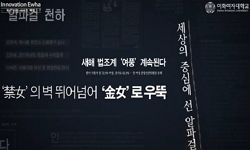본고는 <고요의 바다>(2021, 전체 8부작)와 <정이>(2023)를 중심으로 2020년 이후 OTT 플랫폼 넷플릭스를 통해 제작 및 송출된 SF콘텐츠의 비(非)인간 담론과 젠더 구도를 관련지어 분석한...
http://chineseinput.net/에서 pinyin(병음)방식으로 중국어를 변환할 수 있습니다.
변환된 중국어를 복사하여 사용하시면 됩니다.
- 中文 을 입력하시려면 zhongwen을 입력하시고 space를누르시면됩니다.
- 北京 을 입력하시려면 beijing을 입력하시고 space를 누르시면 됩니다.

한국형 SF가 구현한 포스트휴머니즘과 페미니즘 : <고요의 바다>(2021), <정이>(2023)를 중심으로 = Posthumanism and Feminism in Korean Science Fiction -Focusing on The Sea of Silence (2021) and Jung_E (2023)-
한글로보기https://www.riss.kr/link?id=A109125517
-
저자
전지니 (한경국립대학교)
- 발행기관
- 학술지명
- 권호사항
-
발행연도
2024
-
작성언어
Korean
-
주제어
주제어: 한국 SF 콘텐츠 ; 넷플릭스 ; 비인간 ; 페미니즘 ; 신파 ; 젠더리스 ; 여성 과학자 ; Key words: K Sci-fi Contents ; Netflix ; Non-human ; Feminism ; Shinpa ; Genderless ; Woman Scientist
-
등재정보
KCI등재
-
자료형태
학술저널
-
수록면
121-154(34쪽)
- DOI식별코드
- 제공처
-
0
상세조회 -
0
다운로드
부가정보
국문 초록 (Abstract)
본고는 <고요의 바다>(2021, 전체 8부작)와 <정이>(2023)를 중심으로 2020년 이후 OTT 플랫폼 넷플릭스를 통해 제작 및 송출된 SF콘텐츠의 비(非)인간 담론과 젠더 구도를 관련지어 분석한다. 두 작품은 공통적으로 재난 이후를 배경으로 인간과 비인간의 공존이라는 문제를 형상화하고 있으며, ‘미투’ 이후 한국 사회의 변화와 조응해 여성 중심의 미래 서사를 만들어가고 있다는 점에서 함께 논의할 수 있다. 이 같은 점을 고려하여 재난에 대한 상상력과 가족주의적 사고를 토대로 만들어진 한국형 SF콘텐츠가 인간과 비인간, 그리고 미래를 사유하는 방식을 파악한다. 구체적으로 부정적인 체제에 대항하는 여성 영웅과 비인간에 대한 형상화를 통한 젠더 담론의 의미와 함께 젠더리스한 상상력의 부재라는 측면을 함께 살펴보도록 한다. 이 같은 논의는 가족주의에 입각해 있는 한국형 SF가 로컬리티를 반영하는 동시에 국제적 보편성을 확보하는 방식을 성찰하는 것으로 나아간다. 이를 위해 <고요의 바다>와 <정이>의 비인간 담론과 페미니즘적 상상력을 재난 이후의 시각화와 여성 과학자라는 형상, 소녀/어머니로 젠더화된 비인간 표상, 가족주의와 연대의 판타지라는 지점으로 구분하여 논의한다. 특히 여성 서사를 다루고 있는 한국형 SF가 페미니즘과 포스트휴머니즘을 어떻게 서사화시키는지를 분석하며, 작품이 노출한 문제를 넷플릭스가 거대한 제작비를 투여하여 익숙한 가족주의를 내세우는 과정에서 드러난 한계와의 관련성 속에서 조명하고자 한다. 곧 전 세계 시청자를 대상으로 한 흥행 지표와는 별도로, 젠더적 관점과 SF로서의 상상력이라는 측면에서 두 작품의 명암을 살펴볼 것이다.
다국어 초록 (Multilingual Abstract)
This study analyzes the discourse of non-humans and gender constructions in science fiction content produced and transmitted through the OTT platform Netflix since 2020, focusing on The Sea of Silence (2021, 8 episodes) and Jung_E (2023). The two wo...
This study analyzes the discourse of non-humans and gender constructions in science fiction content produced and transmitted through the OTT platform Netflix since 2020, focusing on The Sea of Silence (2021, 8 episodes) and Jung_E (2023). The two works are discussed together as they both depict the issue of coexistence between humans and non-humans in a post-disaster setting, and they create female-centered future narratives in response to changes in Korean society after ‘Me Too’. In light of these considerations, this paper identifies how Korean science fiction content, which is based on the imagination of disaster and familism, conceptualizes humans, non-humans, and the future. Specifically, it examines the implications of gender discourse through the representation of female heroes and non-humans who fight against negative systems, as well as the absence of a genderless imagination. The discussion then reflects on how Korean science fiction, based on familism, reflects locality while securing international universality. To this end, the nonhuman discourse and feminist imagination in The Sea of Silence and Jung_E will be discussed in terms of post-disaster visualizations and representations of female scientists, gendered nonhuman representations as girls/mothers, and fantasies of familism and solidarity. Particularly, the analysis explores how Korean science fiction with female narratives narrativizes feminism and posthumanism, and examines the problems exposed by the works in relation to the limitations posed by Netflix Korea’s enormous production budget and its familiar familism. It delves into the problems of the two works in terms of their gendered perspectives and imagination as science fiction, separate from their box office figures for global audiences.
동일학술지(권/호) 다른 논문
-
- 한국드라마학회
- 문선영
- 2024
- KCI등재
-
- 한국드라마학회
- 이은구
- 2024
- KCI등재
-
예술가의 말의 기능과 ‘아티스트 토크’ 프로그램의 역할
- 한국드라마학회
- 서지영
- 2024
- KCI등재
-
한국 TV 드라마의 공통감각으로서 ‘슬픔’ 형성과 ‘눈물’의 수행 방식 연구
- 한국드라마학회
- 김소은
- 2024
- KCI등재




 KCI
KCI KISS
KISS






